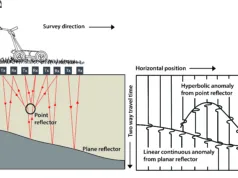The rocks does not differ only by their macroscopic or microscopic properties studied field geologists or petrologists. They also differ by their chemical and physical properties. Hence as the rocks differ according to their origin, structure, texture, etc. they also differ by their density, magnetisation, resistivity, etc. The bad news is that the physical properties do not always clearly correlates with geological classifications and do not necessarily easily translates into the geological terms.
The use of physics to study the interior of the Earth, from land surface to the inner core is known as solid earth Geophysics
Solid Earth Geophysics can be subdivided into Global Geophysics or pure Geophysics and Applied Geophysics.
Who hires geophysicists?
- Energy Companies
- Mining Companies
- Government Jobs
- Engineering Consultants
- Environmental Consultants
How Do Geophysicists “Look at” Rocks?
- Measure properties such as density, resistivity, magnetic properties, elastic moduli, radioactivity, etc…
- Use these properties to infer rock type / composition
- “Indirect” approach, but offers information that is not possible to visually obtain.
Global Geophysics
Global Geophysics is the study of the whole or substantial parts of the planet. Geophysical methods may be applied to a wide range of investigations from ٣ studies of the entire earth to exploration of a localized region of the upper crust, such as plate tectonics, heat flow and paleomagnetism.
Applied Geophysics
Applied Geophysics is the study of the Earth’s crust and near surface to achieve an economic aim, or making and interpreting measurements of physical properties of the earth to determine subsurface conditions usually with an economic objectives ( e.g. discovery of fuel or mineral deposities).
Comprises the following subjects:
- Determination of the thickness of the crust (which is important in hydrocarbon exploration.
- Study of shallow structures for engineering site investigations.
- Exploration for ground water and for minerals and other economic resources.
- Trying to locate narrow mine shafts or other forms of buried cavities.
- The mapping of archaeological remains.
- Locating buried piper and cables
Engineering Geophysics
Engineering Geophysics is application of geophysical methods to the investigation of nearsurface physico-chemical phenomena which are likely to have (significant) for the management of the local environment.
- Geophysics can be used to investigate contaminated land to locate polluted areas prior to direct observations using trail pits and boreholes. Large areas can be surveyed quickly at relatively low cost.
- The alternative and more usual approach is to use a statistical sampling techniques, the geophysical survey is used to locate anomalous areas and there will be a higher certainly that the constructed trail pits and boreholes will yields useful results.
- Geophysics is also being used much more extensively over landfills and other waste repositories. – Geophysics can be used to locate a corroded steel drum containing toxic chemicals. To probe for it poses the real risk of puncturing it and creating a much more significant pollution incident.
- By using modern geomagnetic surveying methods, the drum’s position can be isolated and a careful excavation investigated to remove the offending (hurt) object without damage. Such approach is cost effective and environmentally safer.
- Geophysics investing of the interior of the earth involve taking measurements at or near the earth’s surface that are influenced by the internal distribution of physical properties.
- Analysis of these measurements can reveal how the physical properties of the earth’s interior vary vertically and laterally.
- Exploration geophysics developed from the methods used in global geophysics
Useful of Geophysics
- Adds information about the 3rd dimension.
- Can truly “look into the Earth”
- Gives less detailed information about much larger areas.
- Results are often “non-unique”
- Usually cannot give information about the past
- Can study non-tangible things…e.g. forces
Relation between Geology and Geophysics:
Geology
It involves the study of the earth by direct observations on rocks either from surface exposures or from boreholes and the deduction of its structures, composition and historical evolution by analysis of such observations.
Geophysics
It involves the study of the inaccessible earth by means of physical measurements, usually on or above the ground surface. It also includes interpretation of the measurements in terms of subsurface structures and phenomena.
Geophysical studies are quantitative and tangible, whereas geological studies are qualitative and descriptive
Physcical Properties of Rocks
The physical properties of rocks that are most commonly utilized in geophysical investigations are:
- Density
- Magnetic susceptibility
- Elasticity
- Electrical resistively or conductivity
- Radioactivity
- Thermal conductivity
These properties have been used to devise geophysical methods, which are:
- Gravity method
- Magnetic method
- Seismic method
- Electrical and electromagnetic methods
- Radiometric method
- Geothermal method
Geophysical Methods
The physical properties of rocks have been used to devise geophysical methods that are essential in the search for minerals, oil and gas and other geological and environmental problems.
Read More – Geophysical Methods Page
Reference
- Dr. El-Arabi H. Shendi ( 2007 ) Introduction of Geophysics, Suez Canal University Faculty of Science, Professor of Applied & Environmental Geophysics




































